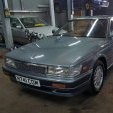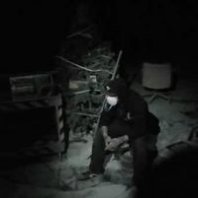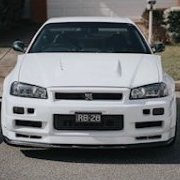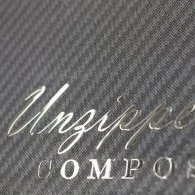
discopotato03
Members-
Posts
4,810 -
Joined
-
Last visited
-
Days Won
3 -
Feedback
100%
discopotato03 last won the day on January 21
discopotato03 had the most liked content!
Recent Profile Visitors
discopotato03's Achievements
-
Borg Warner EFR Series Turbo's V 2.0
discopotato03 replied to Piggaz's topic in Forced Induction Performance
One of my mentors speciality was rallying early Datsuns . There came a time when turbocharging was the thing to boost the performance of Rally and Circuit race cars - call it the Group A era . Traction was always the issue on the dirt and AWD was the answer for this . Manufacturers did all things fair and foul so the regulators had to find a way to level the performance playing field . Inlet air restrictors was their solution . Simple and effective - you can have as much air as this gadget can flow and no more . So , the first thing they found was that conventional performance turbos didn't work . They'd get to the flow limit of the restrictor and fall flat on their face . So the next step was to downsize their turbos so that most of its effective range fell within the flow limits of the restrictor . Some of you may remember that the TME spec Evo 6 4G63s had a TD05 turbo with a smaller compressor than the std or GSR spec Evo 6 . They came on boost earlier and made rated boost (from memory) at something like 2800-3000 revs . We can do a lot of guessing about choke flows , my theory go like this Just about everything on planet earth air wise is pressurised by our basic 1 Bar at sea level . 1 Bar being approx 14.7 Psi/100kpa/1000Mb . Many people have a hard time believing that their is no such thing as "suck" , death and tax man aside . When an engine draws air in it's actually being pushed in by atmospheric pressure . The roads to high airflow with only 1 bar pushing is a lot of area . With turbos again you won't get any more air in than the atmosphere can push through a given orifice . When the compressor flow starts to out run the restrictor the pressure starts to drop ahead of it to the point where its so low that the atmosphere can't push any more in - it literally chokes . So you are left with a situation where you have to make best use of the air volume available and have the engine in a state of tune to work effectively with this flow ceiling . What the Rally teams ended up with was something more like a petrol fired diesel performance wise . Lots of torque at low to medium revs and forget about much over 5000 . If you look at pics of Grp A rally turbos they're nothing like anything else . Compressors look smallish with small trims in materials like magnesium . Turbines are made of very high temp spec alloys and possibly a little larger in diameter with medium trim sizes . As I said initially they gave up on twin scroll for the reasons Geoff mentioned and had ALS to virtually have them up to speed from a high idle . With Garrett I can't say but I know Mitsubishi put a lot of effort into Grp A homologation special turbos and these turned up on production cars . Evos 1 and 2 used a TD05H 16G - I think the "small" 16G 60 odd mm compressor . Evo 3 got the same TD05L turbine but with a unique compressor wheel of similar dimensions to the "big" 68mm 16G diesel wheel . Everyone calls this Evo 3 16G compressor , the difference aside from aero geewizzadry was that the wheels hub and front boss were reduced in area and mass so less weight and more blade area for a given inducer/exducer size . As we know Evos 4-9 went twin scroll and reverse rotation possibly with the same wheels aero . Twin scroll gave them the ability to wake up quickly and interestingly Mitsy turbine housing sizes increased from around 9cm to 9.8 and 10.5cm from Evo 6 . There were a few TD05Hr variations in the Evo 6 era - aimed at spinning up earlier and being able to cope with the restrictor in Rally trim . The TMEs turbine was TiAL to make it lighter and the compressor was reduced in size to make it live within a lower total air flow rate . Beyond Grp A but there were also a couple of special TD05s for the Evo 9 RS . They were a limited option of the TiAL turbine but with a light weight magnesium compressor wheel as well . There was two versions of these , first the flat back compressor which cracked and second the tulip backed one that didn't . I have one of those buried somewhere . Also a third version that had the reduced sized compressor wheel . Interestingly all Evo 9 turbos have the larger compressor housing with I think increased diffuser diameter . Any way , If it were me trying to spec a turbo with a restrictor I'd be finding out the restrictors max flow and working the compressor and housing numbers around that and the engines capacity . If anything I'd start with smallish compressors in relation to turbine size which is basically how early generation diesel turbos are . My 5c spent . -
Borg Warner EFR Series Turbo's V 2.0
discopotato03 replied to Piggaz's topic in Forced Induction Performance
One thing I can add is that I'd say what you mean by GT"29"71R is that it probably has that ancient cropped GT30 turbine in it . If so these were a GT30 UHP turbine that had the blades shortened - trying to fudge a turbine size in between GT28 and GT30 . The idea was to make effectively a smaller more responsive turbine than a GT30 . It doesn't work because having the GT30 sized turbine hub with shorter blades isn't the same as having a purpose designed turbine with the same inducer and exducer diametres . Long story short these GT29 turbines were never efficient in any turbo . Too much hub mass and volume for too little blade area . I think as mentioned the G25 should be a step in the right direction . Something else to think about is the turbo tech used in the Group A rally days of inlet restrictors . A huge amount of research went into their turbos and they were very different to virtually everything else . From what I remember they were trying to get the things to come on as early as possible and make ginormous torque over a reasonably narrow rev range . The numbers were something like 650 Nm of torque from 2000cc and it was all over at 53-5500 revs . I think early on manufacturers started doing the twin scroll thing ie some EJ20s and most 4G63Ts but in the end it was simpler to use anti lag systems with more conventional style open manifolds and turbine housings . -
RB25 td06-20rx vs 25g
discopotato03 replied to Prof_Finesser's topic in Forced Induction Performance
Short of time at the moment but . Recently I noticed that Mitsubishi released a turbine called (from memory) TF06 - which is sort of similar dimensions to a GT30 turbine . The turbo is called TF06-18K and similar wheel wise to a GT3076R . They have the most modern Mitsy wheel designs AFAIK . -
GT3076 V G30-770 dyno results back to back - FJ20
discopotato03 replied to Gareth87's topic in Forced Induction Performance
I forgot to add that SSS 200Bs had drive shafts with hooks type uni inner joints I think similar to a K or Z . Pretty sure 910SSS had pod and CV joints , and an R180 diff . Probably similar to Aus spec MR30 2.4E . DR30 of course had the larger R200 and shafts and larger solid rear brakes . Their R200 LSD has less plates than the Nismo and a spacer . To make better simply remove the spacer and fit a full set of plates . -
GT3076 V G30-770 dyno results back to back - FJ20
discopotato03 replied to Gareth87's topic in Forced Induction Performance
No they don't . The cross member mounts aren't there and neither is the rear R series diff mount . The closest thing you can get is the 200B SSS rear end . To fit this system up to an Australian 910 you have to open up the tops of the rails . From underneath the box sections the outer skin has the relevant holes but the inner doesn't . I chopped the rear pin mounts out of some early type Skyline at a wrecker . Arthur Jackson machined them to sit in the opened box section and welded strengthening webs inside the rails . The X member mounting studs were I think 1600 type with the tapered shank . JDM 910s and R30s have the studs welded into the rails . JDM 910s have a different body cross brace to ours and the R series diff is suspended from a single horizontal bolt . Mine used a moustache bar that Stuart Wilkins used to make and had vertical bolts that went through strengthened sections of the boot floor - from memory . I think that bar is still here with urethane bushes . The 910 or 200b SSS rear setup would be lighter and the struts would line up better . Funnily enough Australian shells have the mount for the IRS type hand brake cable clevis . Back in the day I tried to sell my IRS FJT'd Bluebird fully engineered for $7000 , no takers . Everyone though they could do it cheaper . I sold most of the bits out of it and the last time I saw that shell it was on the back of a truck with the crane boom through the roof . -
GT3076 V G30-770 dyno results back to back - FJ20
discopotato03 replied to Gareth87's topic in Forced Induction Performance
Yep , airflow through a 910s engine bay isn't brilliant . Factory standard with the carburetted L20B they used elec fuel pumps to get around fuel boiling in the carbs and hard pipes . I think the issue is convincing warm/hot air to flow down around the gearbox and out underneath . The two factory cars with FJTs from memory were R30 Skylines and some S12s , both of them had fairly long engine bays particularly R30s . The FJ looked weird in my DR30 - being so far forward . You probably don't want to hear this but the two biggest issues with 910s are cooling and rear suspension woes . I solved most of the cooling ones but with a lot less power than you have . The std 4 link rear is pretty hopeless , with any body roll the diagonal top links pull the inside wheel forward and makes it try to rear steer . This would have been part of the reason why S1 Bluebirds had such soft sloppy rear suspension bushes , the S3s were better . Mine was aggravated by the Detroit locker I ran because I couldn't afford a Nizmo H190 clutch LSD . Highly amusing in a straight line . I remember out running some clown in a 351 XB up the old Woronora bends west of Sutherland one afternoon . Detroits are great if all you want is grip but they will crack/tear the rear suspension body mounts of cars like Bluebirds . It's also funny taking off from the lights with D lockers if both sides aren't locked . First all the drive comes through the locked side then the other side lines up and engages with a crash that makes you think you've broken an axle . My first attempted fix was a one off 5 link Panhard system , it didnt rear steer as much but to get it to work properly would mean raising the top links and housing them in "boxes" where the rear seat pan is . Some classes of rally BDA Escorts allowed this and it works well from a grip point of view - hardly practical in a road registered car . I knew of one Rally Stanza this was done to and it worked too well , as in the rear didn't want to unstick which doesn't work on the dirt .My second try was to graft in the whole DR30 R200 semi trailing arm IRS setup . Again better but heavier as well . I look at Datsuns semi trailing arm system as half way between live axle and proper multi link IRS . Its issue is that you get significant toe and camber changes as the suspension rises and falls . It was more comfortable - and who doesn't like the R200 diffs shafts and brakes after Astrayan content garbage . Anyway Nissan solved many of these issues with S13s and later . I'd had enough of 80s issues , with the DR30 it was horrible drag link steering and no spares for steering boxes . I bypassed the S series and went with a GTS25T . -
GT3076 V G30-770 dyno results back to back - FJ20
discopotato03 replied to Gareth87's topic in Forced Induction Performance
I still have my R33 , it sees the light of day about twice a year . -
GT3076 V G30-770 dyno results back to back - FJ20
discopotato03 replied to Gareth87's topic in Forced Induction Performance
This takes me back . I mucked around with S1 Bluebirds through the 1990s and I also went down the FJ20ET road . Mine was basically a DR30RSX in a 910 shell , it had the DR30 R200 rear end grafted in as well . Cooling is a pain with them . I used an R32 GTR radiator and a very early Plazmaman intercooler . Arthur Jackson went to a lot of trouble to basically reconstruct the radiator support panel to fit that intercooler . It needed the OE Bluebirds bonnet catch section removed and a Datsun 1600 dog cock style catch system fitted . You have to cut a section out of the underneath of the bonnet and weld a piece in to take it . All worked really well . A bit OT but the best master cylinder system I found was to get a 910SSS booster and get it opened up and re orient the outer half 180 deg from std . That way you can fit a JDM Nabco or Tokiko master , I think they were 1 inch . The Australian booster is garbage and the PBR/Girlock 13/16 master worse . I think I had the external proportioning valve but eventually went to a Rally style adjustable one . Most of the OE stuff is probably unobtaneum nowdays , I was lucky enough to rape front cuts for the small stuff after others had bought the Z18 and box . -
I agree , law of diminishing returns . Thanks for your G30-660 results , it'd be the one I'd use from the G series range .
-
Your calls but I think the filter bypass valve is there for two reasons . Firstly some careless or clueless never change oil and filters . Secondly really cold climates may make it hard for oil to flow through the filter . When I was playing with L20B fours back in the late 80s I had that bypass removed and plugged , I was using a remote filter as well . Note that L20Bs use a larger Z115 style filter std . I don't think oil filters magically clog up , if you are prepared to change your oil and filter at reasonably regular intervals you should never have a problem that a filter bypass could solve .
-
Just thought I'd check in with something that you may not have seen . GCG Turbos is advertising a G25-550 with a T3 flanged integral waste gate turbine housing in 0.73 AR for Nissan Patrol diesels - I think the TD42 engine . I think there is also a 0.64 AR turbine housing version . https://gcg.com.au/turbo-charger-garrett-g25-550-0.73a%2Fr-iwg-std-t3-nissan-patrol-td42-outlet-g871389-td42-73.html?ref_cat_id=Performance-Turbochargers-Garrett-G-Series With what Geoff just mentioned the 0.73 AR could be ok with that turbine if you wanted the typical 300ish Kw at the wheels in an R33/34 GTST/GTt . The G25-660 may be more suitable depending on power goals .
-
FJ20 turbo choice - over 500whp
discopotato03 replied to Gareth87's topic in Forced Induction Performance
Many years ago I had an FJ in a Ser 1 TRX . Was a major operation to reconstruct the rad support panel . I used an R32 GTR radiator with DR30 fans and an early Plazma intercooler . Arthur Jackson did the fab work inc the cut and welded bonnet to take a 1600 dog cock style bonnet lock . Turbo wise a GT3040R or as some say GT3082R is definitely old school . The HKS version worked better than the Garrett marketed one , the difference was the 50 trim compressor in the HKS compared to the 56 trim one in the Garrett marketed version . -
FJ20 turbo choice - over 500whp
discopotato03 replied to Gareth87's topic in Forced Induction Performance
Bluebirds always had issues with hot engine bays , the std L20B needed an elec fuel pump to circulate enough to stop fuel boiling issues . They don't appear to have good airflow through the engine bay meaning down past the transmission and out underneath . The FJ20ET takes up a lot more space than the L Series and this doesn't help . -
Intake manifold/plenum options
discopotato03 replied to Chopstick Tuner's topic in Forced Induction Performance
With the numbers Hypergear is getting from Neo 25 original inlet manifolds I wouldn't go aftermarket .









